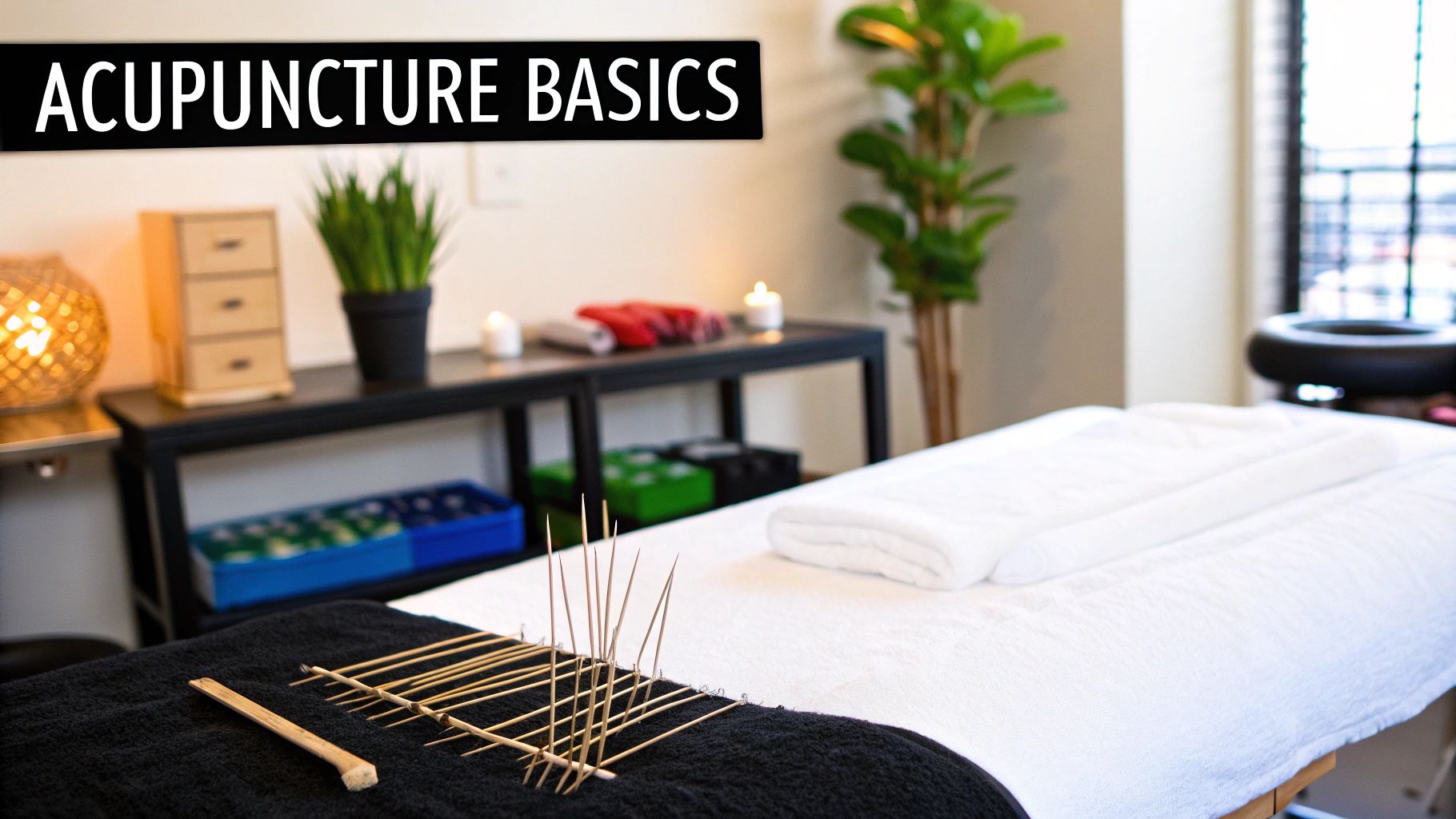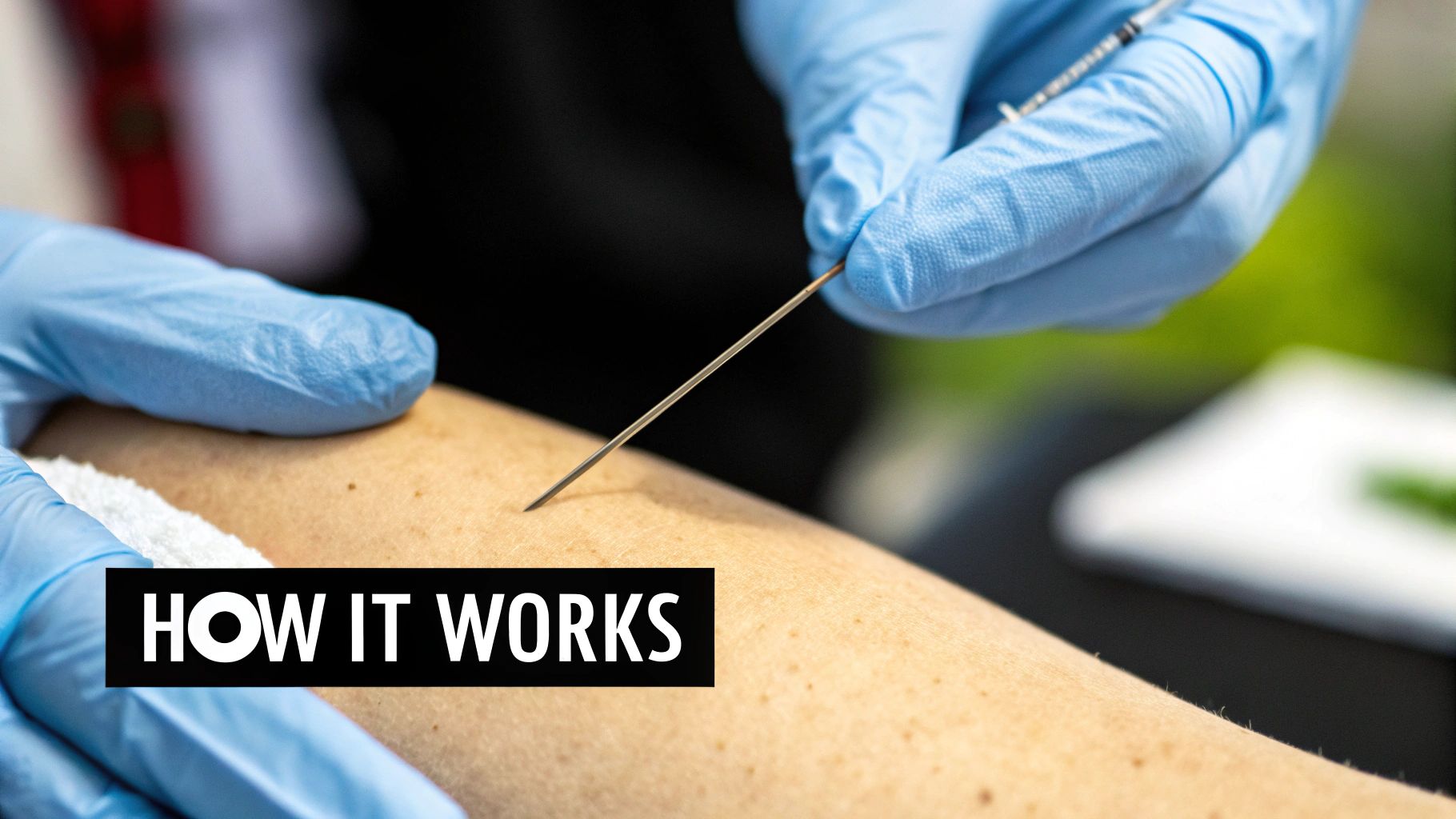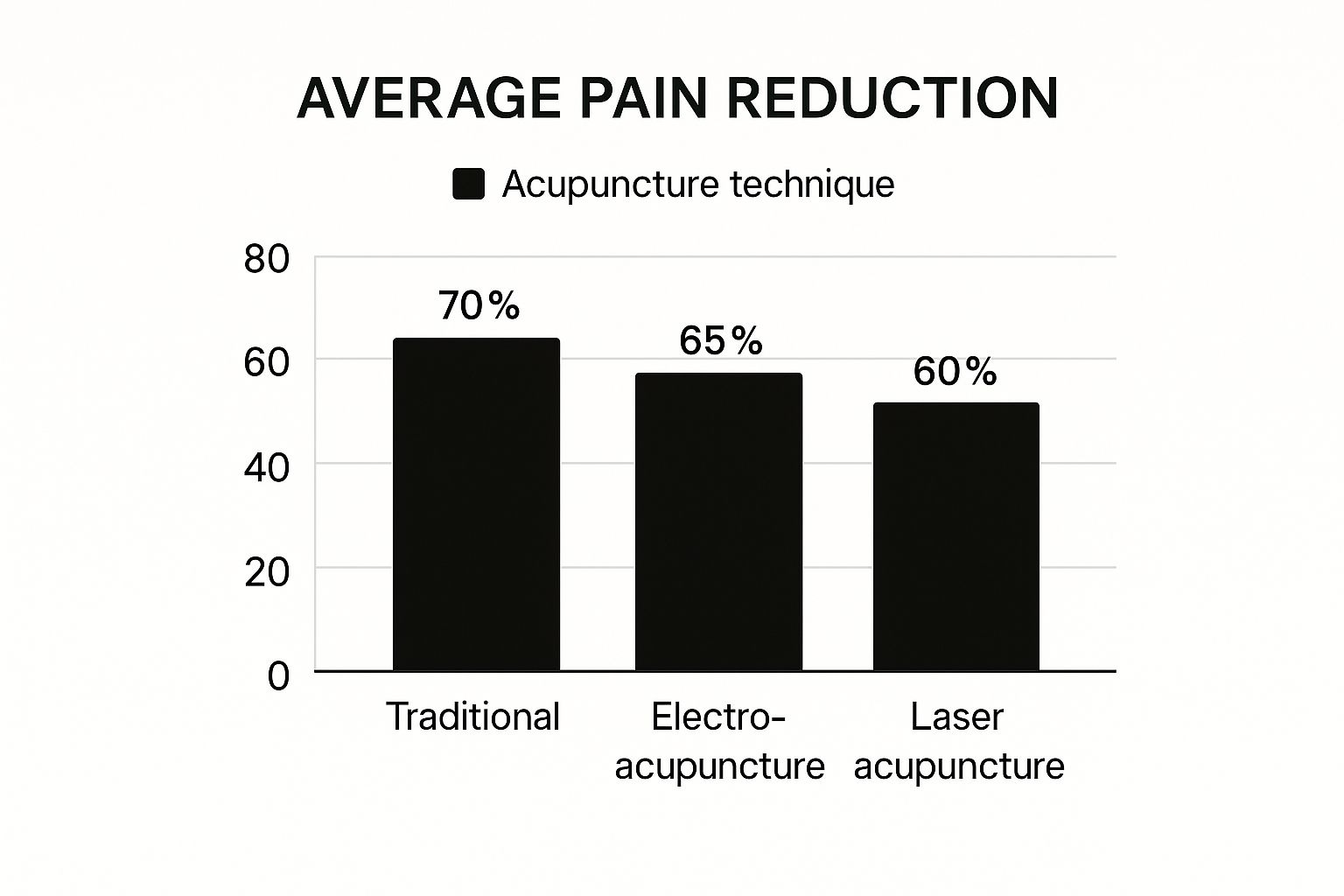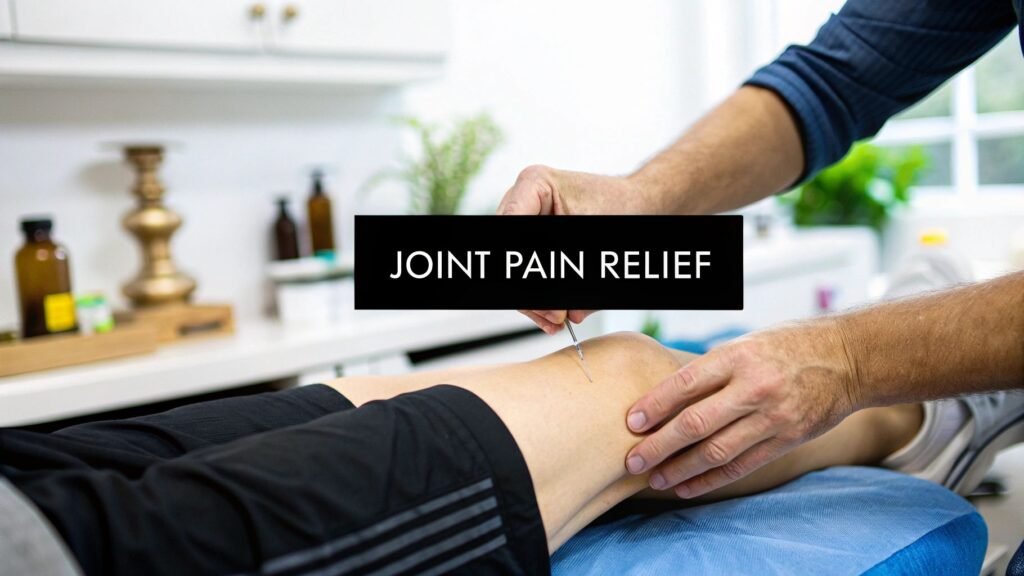If you're looking for answers on how to manage persistent joint pain, you've probably wondered: does acupuncture for joint pain actually work?If you're looking for real solutions to manage persistent joint pain, you've likely asked the question: does acupuncture for joint pain actually work? The short answer is yes. A solid and growing body of scientific evidence confirms its effectiveness, which is why it has become a trusted option for so many people.
Finding Lasting Relief from Joint Pain with Acupuncture

This guide goes beyond the simple "yes" to explore how this ancient practice provides modern relief. We'll get into the science of how it works, what you can expect during a treatment session, and which joint conditions tend to respond best. The goal here is to give you a clear, honest understanding so you can decide if acupuncture is the right next step for you.
This isn't just about anecdotal success stories; the shift toward acupuncture is a measurable trend. Over the last two decades, its use for pain management in the United States has climbed significantly. In fact, between 2002 and 2022, the number of U.S. adults using acupuncture more than doubled, from 1.0% to 2.2%.
What's really telling is why people are turning to it. In 2022, about 72.8% of those who used acupuncture did so specifically for pain. That statistic highlights its growing role as a primary, non-drug option for finding relief. For a closer look at these trends, you can explore the data from recent U.S. health surveys.
Key Acupuncture Concepts for Joint Pain at a Glance
Before we go deeper, it helps to have a handle on the core concepts. Think of acupuncture as a way to communicate with your body's nervous system, prompting it to kickstart its own natural healing and pain-control processes. The underlying mechanisms are complex, but the fundamental ideas are quite intuitive.
This table breaks down the main principles behind how acupuncture helps with joint pain.
| Concept | Mechanism for Joint Pain Relief | Primary Benefit |
|---|---|---|
| Neuromodulation | Stimulates nerves to release natural painkillers (endorphins) and block pain signals. | Reduces the immediate sensation of pain. |
| Anti-Inflammatory Effect | Increases circulation and prompts the release of substances that reduce swelling. | Calms inflammation and stiffness in the joint. |
| Tissue Regeneration | The micro-trauma from needles triggers the body's natural healing cascade. | Promotes long-term repair of damaged joint tissues. |
| Restoring Flow (Qi) | In traditional terms, it unblocks stagnant energy to restore balance and function. | Improves overall joint mobility and reduces chronic ache. |
Grasping these basics provides a solid framework for understanding the connection between ancient theory and modern clinical results.
Acupuncture is not just about placing needles; it's about strategically stimulating the body's own powerful pain-relief and anti-inflammatory mechanisms. It empowers the body to heal itself from within, rather than relying solely on external interventions.
With this foundation, we can better appreciate the scientific evidence and practical applications of using acupuncture for joint pain.
What You Will Learn
This guide is designed to be your complete resource, giving you clarity and confidence as you consider your options. We will cover several important areas to help you make an informed decision about your health.
- The Science Explained: We'll break down how precisely placed needles can calm pain signals, reduce inflammation, and encourage healing right where you need it.
- Clinical Proof: We’ll look at the research validating acupuncture's effectiveness, especially for common issues like osteoarthritis.
- Your First Session: You'll get a clear, step-by-step walkthrough of what to expect during a treatment, from the initial consultation to the session itself.
- Conditions Treated: Find out which specific joint problems, from nagging knee pain to rheumatoid arthritis, respond most effectively to this therapy.
- Practical Answers: Get straightforward answers to common questions about safety, cost, and insurance coverage.
How Acupuncture Calms Joint Pain Signals
To really get a handle on how acupuncture works for joint pain, it’s helpful to look at it from two different but complementary angles: the ancient philosophy it was built on and the modern science that’s now explaining it. Both give us a clear picture of how something as simple as a fine needle can bring about such profound relief.
The traditional view is all about a concept called Qi (pronounced "chee"). Think of Qi as your body's vital energy or life force. In this framework, your body is crisscrossed by a network of pathways, almost like rivers, which are called meridians. Qi is the water flowing through these rivers, nourishing everything, including your joints. When that flow is strong and steady, you're in good health.
But things like an injury, chronic stress, or illness can create disruptions—picture a dam blocking a river. When Qi gets stuck or stagnant in one area, it can manifest as pain, stiffness, and inflammation. The whole point of acupuncture is to insert needles at very specific points along these meridians to break up those blockages, get the Qi flowing smoothly again, and restore the body's natural balance.
The Scientific Bridge to Pain Relief
Now, let's switch gears to what modern science has to say. Researchers have found concrete, biological explanations for these effects, essentially translating the ancient concepts into the language of physiology and neurology.
When an acupuncturist inserts a needle, it’s not just a random poke. It's a precise stimulation of nerves, muscles, and the connective tissue web that runs throughout your body. This stimulation sends a signal straight to your central nervous system, telling it to wake up and pay attention.
You can think of it like hitting a reset button. The needle's presence prompts the brain to react in a few very important ways:
- Releasing Natural Painkillers: Your brain gets a message to release endorphins—your body’s own morphine-like chemicals. These are powerful analgesics that effectively turn down the volume on pain signals.
- Reducing Inflammation: Acupuncture can trigger the release of anti-inflammatory substances, which helps calm the swelling, heat, and irritation in an arthritic or injured joint. This is a huge factor in easing chronic aches and improving your range of motion.
- Improving Blood Flow: The local stimulation boosts circulation right where you need it most. Better blood flow brings more oxygen and nutrients to damaged tissues and, just as importantly, flushes out the inflammatory byproducts that contribute to pain. This whole process helps speed up healing.
From a scientific standpoint, acupuncture isn't a mystical process. It’s a therapy that kicks off a chain reaction of real, measurable physiological responses. It prompts your body to use its own powerful, built-in systems for managing pain and healing itself.
Combining Traditional Wisdom and Modern Evidence
The best part is that you don't have to choose between the traditional and scientific explanations. They actually fit together beautifully to give us the full story. In fact, many of the meridian pathways described centuries ago happen to map surprisingly well onto the major nerve pathways and clusters of blood vessels that modern anatomy has identified.
Here’s a practical example: An acupuncturist treating knee pain might choose points on the lower leg. From a traditional perspective, they’re clearing a blockage in the Stomach or Spleen meridian to restore flow to the knee. From a scientific view, they're stimulating nerves that share a pathway with the knee joint, which tells the brain to send pain-relieving endorphins and anti-inflammatory agents right to the source of the problem.
This dual-lensed approach is what makes acupuncture such a robust therapy for joint pain. It works holistically by addressing the body’s overall balance while also triggering very specific, localized healing mechanisms. The result isn't just a temporary fix; it's a deeper, more lasting form of relief that helps the joint heal and function better for the long haul.
Exploring the Evidence for Acupuncture in Joint Pain Treatment

While the theories behind acupuncture are compelling, what really matters is proof. Does it actually work? Fortunately, we don't just have to rely on personal stories—the scientific community has spent decades putting acupuncture for joint pain to the test. The results are in, and they paint a very clear picture.
To really trust the research, you have to understand how scientists test something like acupuncture. It’s not enough to just compare it to doing nothing. The gold standard is to compare it against a "sham" or placebo treatment. This crucial step helps us know if the benefits come from the specific placement of needles or just the general effect of receiving any kind of treatment.
So, what does a sham treatment look like? It might involve using retractable needles that don't actually break the skin or placing real needles in random spots that don't correspond to any traditional acupuncture points. When real acupuncture consistently outperforms both the no-treatment and sham groups, we know we're seeing a genuine therapeutic effect.
Landmark Studies and Key Findings
Over the years, a massive amount of research has piled up, building a strong case for acupuncture in pain management, especially for joints.
One of the most powerful studies was a huge 2012 meta-analysis that combined the results from nearly 18,000 patients across dozens of high-quality trials. It looked at chronic pain, including osteoarthritis, and the conclusion was undeniable: true acupuncture delivered more significant pain relief than both sham acupuncture and no treatment at all. It confirmed that the effects are real and go beyond the placebo effect.
This kind of rigorous research is exactly why major medical organizations have started to officially recommend acupuncture. It’s moved from the fringes to the mainstream.
The American College of Rheumatology, for instance, now conditionally recommends acupuncture for people dealing with osteoarthritis in their knees, hips, or hands. Their guidelines are based on solid evidence that it leads to meaningful improvements in both pain and physical function.
What the Evidence Means for You
All this research gives us confidence that choosing acupuncture for joint pain is a decision grounded in science. It’s not a hopeful experiment; it’s a legitimate therapy that has earned its place as a reliable tool for managing chronic conditions like osteoarthritis.
Here are the key takeaways for anyone considering treatment:
- Real Pain Reduction: Study after study shows that acupuncture significantly lowers pain scores for people with joint pain, especially in the knees and hips.
- Better Movement: It's not just about feeling less pain. Patients often experience better mobility, improved flexibility, and a real boost in their overall quality of life.
- A Safe Alternative: For those who want to avoid or can't tolerate medications like NSAIDs, acupuncture is an excellent non-drug option with a very low risk of side effects.
The evidence is clear: the benefits of acupuncture are tangible. For anyone battling persistent joint pain, it’s a credible and effective part of a smart pain management plan. To see how this can be tailored to your own needs, you can learn more about our specific approach to acupuncture for chronic pain.
What to Expect During Your First Acupuncture Session

Walking into your first appointment for acupuncture for joint pain can feel a little intimidating if you don't know what's coming. But it’s a gentle, straightforward process designed entirely around your comfort. Knowing the flow of a typical session—from the initial chat to the treatment itself—can help ease your mind and set you up for a great experience. A session really breaks down into three simple parts: the conversation, the treatment, and a quiet period of rest.
Believe it or not, your session starts with a conversation, not with needles. A good acupuncturist needs to see the whole picture, not just the spot that hurts. This initial chat is the foundation for a treatment plan that gets to the root cause of your joint pain.
The Initial Consultation and Diagnosis
Think of this first step as holistic detective work. Your practitioner will want to know everything about your specific joint pain—when it started, what it feels like (is it sharp, dull, or a deep ache?), and what you've noticed makes it better or worse. But they won't stop there. They’ll also ask about your overall health, from sleep quality and digestion to stress levels and daily energy.
To get a deeper understanding, your practitioner will likely use a couple of classic diagnostic techniques from traditional Chinese medicine. These often include:
- Looking at your tongue: The color, shape, and coating on your tongue can reveal a surprising amount about your body's internal balance and circulation.
- Taking your pulse: An acupuncturist feels the pulse on both wrists, but they're assessing more than just your heart rate. They are feeling for subtle qualities in different positions, which correspond to the health of your body’s various energy pathways.
This thorough intake is what makes the treatment truly personal. It’s not a one-size-fits-all approach; it’s a plan designed specifically for you, targeting both your joint pain and your overall well-being.
The Treatment and Needle Placement
After your consultation, you’ll get comfortable on a treatment table, and the practitioner will begin placing the needles. If you’re picturing a hypodermic needle, let that image go. Acupuncture needles are sterile, used only once, and are incredibly fine—many are no thicker than a strand of hair.
Most people feel very little when the needles are inserted. You might sense a tiny prick, a brief tingle, or a dull, heavy sensation around the needle. This feeling is known as “De Qi,” and it's a good sign! It means the needle has connected with the body's energy and the treatment is working. The goal is gentle stimulation, never sharp pain.
Your practitioner's primary goal is your comfort and relaxation. The treatment should feel therapeutic, not stressful, allowing your body’s nervous system to shift into a healing state.
The number of needles can vary, but a typical treatment for joint pain might involve 10 to 20 needles. Some will be placed near the painful joint, but others might be located on your arms, legs, or back to address the systemic imbalances contributing to the problem.
Once the needles are set, the lights are often dimmed, and you’re left to rest quietly for about 20 to 30 minutes. This is where the magic happens. Many people find this part of the session incredibly relaxing and meditative; it’s common to even drift off to sleep. During this time, the needles are signaling your body to reduce inflammation, release its own natural painkillers, and find its way back to balance. When the time is up, the practitioner will come back in to gently remove the needles, a process that is quick and painless.
Common Joint Conditions That Respond To Acupuncture
One of the biggest misconceptions about acupuncture is that it's a one-size-fits-all remedy for pain. The reality is far more nuanced. An experienced practitioner doesn't just treat "joint pain"; they tailor the treatment to the specific mechanics and root causes of pain in different parts of your body. Its real strength lies in this adaptability.
Acupuncture truly shines when dealing with conditions driven by inflammation, restricted circulation, and those nagging, chronic pain signals your body can't seem to turn off. By looking at which ailments have a strong track record of responding, you can see how acupuncture for joint pain might work for you.
This chart gives you a sense of how different acupuncture techniques stack up in terms of average reported pain reduction.

While every method clearly provides relief, the data underscores why traditional acupuncture often leads the pack and remains the bedrock of modern practice.
Osteoarthritis Of The Knee, Hip, And Hands
If there's one condition that has been extensively studied with acupuncture, it's osteoarthritis (OA). This is the classic "wear and tear" arthritis, where cartilage gradually breaks down, causing pain, stiffness, and making it harder to get around. It's by far the most common joint issue we see in the clinic.
For OA in the knee, for instance, we focus on points directly around the joint to boost local blood flow, calm inflammation right at the source, and trigger the brain to release its natural painkillers, endorphins. When dealing with the hip or hands, we take a broader view, targeting both local points and related ones along the arms and legs to address the entire pain pathway.
The clinical evidence here is quite compelling. A major 2018 review, which synthesized data from 10 different studies involving over 2,400 people, concluded that acupuncture was significantly more effective than getting no treatment at all. It even held its own against common NSAID medications, making it a powerful option for those wary of long-term side effects.
Rheumatoid Arthritis
Rheumatoid arthritis (RA) is a different beast altogether. Unlike OA, RA is an autoimmune disease where the body mistakenly attacks its own joints, leading to intense inflammation, swelling, and pain. While acupuncture can't reverse the disease, it’s a fantastic complementary therapy for managing the day-to-day symptoms.
Here, the strategy shifts. The goal is to help modulate the immune system and bring down that systemic inflammation. By calming the nervous system and improving circulation, acupuncture can ease the intensity of painful flare-ups, reduce morning stiffness, and help combat the fatigue that so often comes with RA. It works right alongside conventional treatments to improve a person's quality of life.
Shoulder, Elbow, And General Joint Pain
Of course, pain isn't limited to the major weight-bearing joints. Acupuncture is also incredibly effective for other common trouble spots.
- Shoulder Pain: For issues like rotator cuff tendinopathy or the dreaded "frozen shoulder," treatment focuses on releasing the chronically tight muscles around the joint, soothing inflammation in the joint capsule, and gently restoring range of motion.
- Elbow Pain: Conditions like tennis elbow and golfer's elbow are classic overuse injuries. Acupuncture helps by relaxing the overworked forearm muscles and encouraging the body's natural healing processes in the affected tendons.
- General Stiffness: Sometimes, you just feel stiff and achy all over without a clear diagnosis. In these cases, acupuncture can provide welcome relief by improving overall circulation and easing that widespread discomfort.
The key takeaway is this: Acupuncture offers a targeted, not a generic, solution. The treatment logic is adapted to the specific joint, whether it's calming inflammation in an arthritic knee or relaxing tense muscles around an aching shoulder.
To illustrate how these approaches differ, let’s compare the treatment strategies for a few common conditions. This table breaks down how the focus and goals change depending on what's causing the pain.
Acupuncture Approaches for Different Joint Pain Conditions
| Joint Condition | Typical Acupuncture Focus | Primary Therapeutic Goal |
|---|---|---|
| Osteoarthritis | Local points around the affected joint to improve circulation and reduce swelling. | Decrease pain, lessen stiffness, and improve joint function and mobility. |
| Rheumatoid Arthritis | Systemic points to help modulate the immune response and calm body-wide inflammation. | Manage pain during flare-ups, reduce stiffness, and improve overall energy. |
| Shoulder/Elbow Pain | Points on related muscle groups and tendons to release chronic tension and tightness. | Relieve strain from overuse, promote tendon healing, and restore movement. |
Grasping these distinctions is the first step toward having a productive conversation with a practitioner about your specific needs and goals. As you continue to research your options, our guide on alternative medicine for pain can provide more insight into how these therapies fit into a holistic wellness plan.
Your Questions About Acupuncture for Joint Pain Answered
https://www.youtube.com/embed/tPywY99ALlM
Deciding to try a new therapy for your joint pain naturally brings up some practical questions. Once you move past the "how it works" and start picturing yourself in the treatment room, the real-world details come into focus. Let's walk through the most common questions we get from patients, giving you the clear, straightforward answers you need to feel confident about your decision.
From what the needles feel like to how many appointments you might need, this section covers the final details you'll want to know before booking your first session of acupuncture for joint pain.
How Many Sessions Will I Need for Joint Pain?
This is easily the most common question, and the answer is always personal. There's no one-size-fits-all number because your treatment plan is tailored to you—your specific condition, how long you've been in pain, and your overall health.
If you’re dealing with a recent, acute injury, you might feel a significant shift after just a few sessions. A typical plan could be one to two times per week for two or three weeks. For chronic issues like osteoarthritis that have been around for years, we’ll need a more sustained approach to achieve lasting relief.
A common starting point for chronic joint pain is one to two sessions per week for four to six weeks. After that initial block of treatments, we'll take stock of your progress and adjust the frequency. Many people find they can switch to a maintenance schedule, coming in just once a month or every few weeks to keep pain and inflammation at bay.
The goal of acupuncture isn't to create a dependency on treatment. It's to kickstart your body's own healing abilities so it can maintain balance on its own. The first few sessions build momentum, and maintenance visits help you hold onto those gains.
Does Acupuncture for Joint Pain Hurt?
The idea of needles can be intimidating, but it helps to know that acupuncture needles are a world away from the hypodermic needles used for shots. They are incredibly thin—many are as fine as a single strand of hair.
Most people feel very little when the needles are inserted. You might notice a tiny pinch or a brief tingle, but "painful" is rarely how it's described. What you're more likely to feel is a unique sensation called "De Qi," which patients often describe as a dull ache, a feeling of warmth, or a gentle heaviness around the needle. This is actually a great sign—it means we’ve activated the point and your body is starting to respond. The whole experience should feel deeply relaxing, not uncomfortable.
Is Acupuncture Safe and Are There Side Effects?
When performed by a licensed and professionally trained acupuncturist, acupuncture is exceptionally safe. Practitioners are required to use sterile, single-use, disposable needles, which all but eliminates the risk of infection.
Side effects are uncommon and usually quite mild. The most common things people experience are:
- A little bruising or a drop of blood at a needle site.
- A feeling of deep relaxation or even mild lightheadedness right after treatment.
- In rare cases, symptoms might flare up for a day before they start to improve. This is often viewed as a sign that the body is recalibrating and beginning to heal.
Serious side effects are extremely rare. The key is to make sure you're seeing a credentialed practitioner who adheres to the highest safety standards.
How Much Does It Cost and Will Insurance Cover It?
The cost of an acupuncture session can vary depending on your location, the acupuncturist’s experience, and how long the appointment is. Your first visit, which includes a detailed consultation, will generally cost more than follow-up appointments.
The good news is that insurance coverage for acupuncture has improved dramatically. Many major insurance carriers now cover acupuncture for specific conditions, especially chronic pain. But every plan is different. It’s always best to call your insurance company directly before starting treatment. Ask them about your coverage for acupuncture for your specific joint pain diagnosis, whether there's a limit on the number of visits, and what your co-pay or deductible will be.
Chronic pain and the stress of navigating healthcare often go hand-in-hand. Interestingly, many of the same principles we use to treat joint pain can also be applied to managing stress. You can learn more in our guide on acupuncture for stress management.

